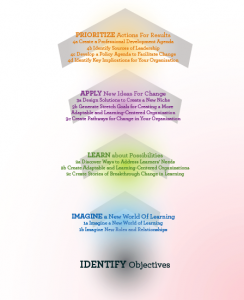One of the challenges of foresight work is to make new insights about the future relevant to our own situations and actionable in meaningful ways. Foresight needs to be matched with processes that help leaders move past “This is interesting, but what does it have to do with my organization?” towards something more like “This reframes our professional development needs (or choices for strategic partners, etc.) and here are 3 things I can do now!”
The KnowledgeWorks Foundation recently released a new toolkit that is intended to help education stakeholders do just this. Creating a New World of Learning: A Toolkit for Change Makers is an action planning guide that helps leaders design and facilitate customized learning experiences that help them think long in order to take action now. The toolkit supports the forecast content that KWF have been developing and sharing for the past several years, such as their 2020 Forecast: Creating the Future of Learning and Learning Agents of 2025.
I worked with KWF to develop the toolkit and one of my goals was to make sure that education stakeholders had an opportunity to engage creatively and play with ideas about the future of education. Rather than look for proven answers, it seemed important to create opportunities for leaders and groups to ask “What if?” and explore possibilities, even if they seem a little crazy or silly. With this in mind we broke out the activities into four sections:Imagine, Learn, Apply, and Prioritize.
Imagine and Learn sections focus on expanding the visions of what is possible in the future of education and developing a shared language and set of concepts to talk about future possibilities. The Apply and Prioritize sections focus on applying new concepts and possibilities to a group’s organization and identifying opportunities for action.
The toolkit works a bit like a Chinese menu. Each section has multiple activities that facilitators can pick from to structure their learning experience. The document is web-enabled so viewers can jump around and check out each section, the resources in the back, end even sample agendas.
There is also a rich set of audio, video, and text based resources to support activities. There are audio and video clip stories in which future learners and learning agents describe their teaching and learning experiences. There are text-based scenarios about future learning systems that describe how stakeholders might interact and how resource might be allocated. And education artifacts from the future provide an opportunity for practicing a bit of future focused archeology. Participants can explore new ideas through hands on activities such as card games, prototyping, storytelling, and news headline generation. And ultimately, there are opportunities for participants to use their new insights to identify new goals and actions for change.
Since the activities are modular, sessions can be flexibly planned to last 2 hours or as longer half or full day sessions. The hope is that this toolkit brings some fun and safe risk taking, and thoughtful play to the education transformation process.

